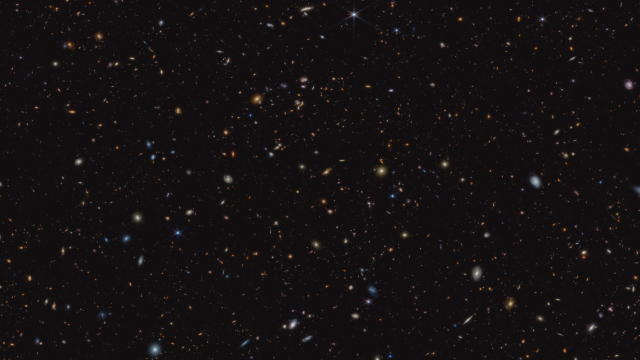This infrared image taken by the Webb Space Telescope comprises more than 45,000 galaxies, many of which existed in the first billion years of the universe.
The image captures the GOODS-S field, a region of space in the direction of the constellation Fornax. It was taken as part of the JWST Advanced Deep Extragalactic Survey (JADES), a program that takes deep field imagery of the cosmos to decipher how the universe as we know it came about.
In the GOODS-S field — which was imaged by Webb’s NIRCam instrument between September 29 and October 10 of last year — lurk galaxies from the universe’s Epoch of Reionization, the period when the first stars and galaxies emerged from the dark primordial haze that preceded it.
During the Epoch of Reionization, the universe’s gassy makeup made it opaque to light; in time, denser regions of the universe clumped together and collapsed under gravity, clearing up the cosmos and giving way to the stars and galaxies that adorn it today.
Many of the light sources in this image are seen as they were when (and before) the universe was a mere 600 million years old; it is now nearly 14 billion years old. The image you see is detailed with countless galaxies, but the true full-res image is simply too large for our website to handle. You can see that version here.
Besides the galaxies in the image merely existing — Webb has made a habit of spotting such remarkably ancient structures — the Webb data revealed to researchers that a flurry of stars were being formed at this ancient moment.
“Almost every single galaxy that we are finding shows these unusually strong emission line signatures indicating intense recent star formation. These early galaxies were very good at creating hot, massive stars,” said Ryan Endsley, an astronomer at the University of Texas at Austin, who investigated these early galaxies, in a NASA release.
These hot, massive stars emitted radiation that ionized the surrounding gas, contributing to the reionization of the universe.
Webb has changed the game for gazing at, and deciphering, the machinations of the early universe. Looking at infrared wavelengths, Webb can cut through gas in the universe to spot some of the cosmos’ earliest light.
“Previously, the earliest galaxies we could see just looked like little smudges. And yet those smudges represent millions or even billions of stars at the beginning of the universe,” said Kevin Hainline, an astronomer at the University of Arizona, in the same release. “Now, we can see that some of them are actually extended objects with visible structure. We can see groupings of stars being born only a few hundred million years after the beginning of time.”
Webb is nearing the first anniversary of its scientific operations, and it has already produced troves of data for astronomers and astrophysicists to refine previous ideas about the universe and introduce new ones.
Set to operate for at least 10 more years — and potentially up to 20 — we’re in for some wonderfully cool imagery, and even more remarkable science.
